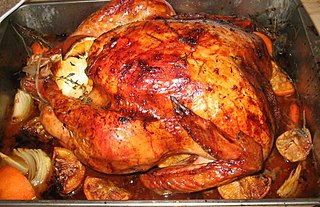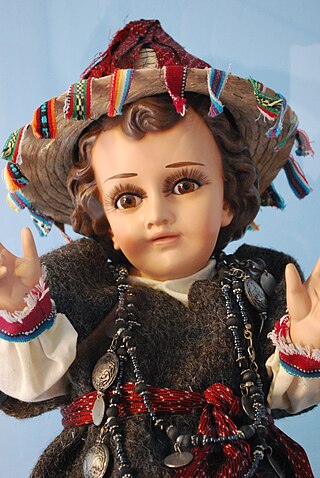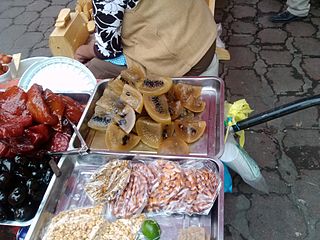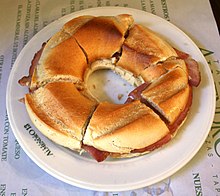
Mexican cuisine consists of the cooking cuisines and traditions of the modern country of Mexico. Its earliest roots lie in Mesoamerican cuisine. Mexican cuisine ingredients and methods begin with the first agricultural communities such as the Olmec and Maya who domesticated maize, created the standard process of nixtamalization, and established their foodways. Successive waves of other Mesoamerican groups brought with them their cooking methods. These included: the Teotihuacanos, Toltec, Huastec, Zapotec, Mixtec, Otomi, Purépecha, Totonac, Mazatec, Mazahua, and Nahua. With the Mexica formation of the multi-ethnic Triple Alliance, culinary foodways became infused.

Brazilian cuisine is the set of cooking practices and traditions of Brazil, and is characterized by European, Amerindian, African, and Asian influences. It varies greatly by region, reflecting the country's mix of native and immigrant populations, and its continental size as well. This has created a national cuisine marked by the preservation of regional differences.

Christmas Eve is the evening or entire day before Christmas, the festival commemorating the birth of Jesus. Christmas Day is observed around the world, and Christmas Eve is widely observed as a full or partial holiday in anticipation of Christmas Day. Together, both days are considered one of the most culturally significant celebrations in Christendom and Western society.

Hungarian or Magyar cuisine is the cuisine characteristic of the nation of Hungary, and its primary ethnic group, the Magyars. Hungarian cuisine has been described as being the spiciest cuisine in Europe. This can largely be attributed to the use of their piquant native spice, Hungarian paprika, in many of their dishes. A mild version of the spice, Hungarian sweet paprika, is commonly used as an alternative. Traditional Hungarian dishes are primarily based on meats, seasonal vegetables, fruits, bread, and dairy products.
Elevenses is a short break taken at around 11:00 a.m. to consume a drink or snack. The names and details vary among countries.

A king cake, also known as a three kings cake, is a cake associated in many countries with Epiphany, the celebration of the Twelfth Night after Christmas. Its form and ingredients are variable, but in most cases a fève such as a figurine, often said to represent the Christ Child, is hidden inside. After the cake is cut, whoever gets the fève wins a prize. Modern fèves can be made of other materials, and can represent various objects and people.

Epiphany, or Eid al-Ghitas, also known as "Theophany" in Eastern Christian tradition, is a Christian feast day commemorating the visit of the Magi, the baptism of Jesus, and the wedding at Cana.

Christmas dinner is a meal traditionally eaten at Christmas. This meal can take place any time from the evening of Christmas Eve to the evening of Christmas Day itself. The meals are often particularly rich and substantial, in the tradition of the Christian feast day celebration, and form a significant part of gatherings held to celebrate the arrival of Christmastide. In many cases, there is a ritual element to the meal related to the religious celebration, such as the saying of grace.

Uruguayan cuisine is a fusion of cuisines from several European countries, especially of Mediterranean foods from Spain, Italy, Portugal and France. Other influences on the cuisine resulted from immigration from countries such as Germany and Scotland. Uruguayan gastronomy is a result of immigration, rather than local Amerindian cuisine, because of late-19th and early 20th century immigration waves of, mostly, Italians. Spanish influences are abundant: desserts like churros, flan, ensaimadas yoo (Catalan sweet bread), and alfajores were all brought from Spain. There are also various kinds of stews known as guisos or estofados, arroces, and fabada. All of the guisos and traditional pucheros (stews) are also of Spanish origin. Uruguayan preparations of fish, such as dried salt cod (bacalao), calamari, and octopus, originate from the Basque and Galician regions, and also Portugal. Due to its strong Italian tradition, all of the famous Italian pasta dishes are present in Uruguay including ravioli, lasagne, tortellini, fettuccine, and the traditional gnocchi. Although the pasta can be served with many sauces, there is one special sauce that was created by Uruguayans. Caruso sauce is a pasta sauce made from double cream, meat, onions, ham and mushrooms. It is very popular with sorrentinos and agnolotti. Additionally, there is Germanic influence in Uruguayan cuisine as well, particularly in sweet dishes. The pastries known as bizcochos are Germanic in origin: croissants, known as medialunas, are the most popular of these, and can be found in two varieties: butter- and lard-based. Also German in origin are the Berlinese known as bolas de fraile, and the rolls called piononos. The Biscochos were re-christened with local names given the difficult German phonology, and usually Uruguayanized by the addition of a dulce de leche filling. Even dishes like chucrut (sauerkraut) have also made it into mainstream Uruguayan dishes.

Chilean cuisine stems mainly from the combination of traditional Spanish cuisine, Chilean Mapuche culture and local ingredients, with later important influences from other European cuisines, particularly from Germany, the United Kingdom and France. The food tradition and recipes in Chile are notable for the variety of flavours and ingredients, with the country's diverse geography and climate hosting a wide range of agricultural produce, fruits and vegetables. The long coastline and the peoples' relationship with the Pacific Ocean add an immense array of seafood to Chilean cuisine, with the country's waters home to unique species of fish, molluscs, crustaceans and algae, thanks to the oxygen-rich water carried in by the Humboldt Current. Chile is also one of the world's largest producers of wine and many Chilean recipes are enhanced and accompanied by local wines. The confection dulce de leche was invented in Chile and is one of the country's most notable contributions to world cuisine.

The Niño Dios of Mexico is a tradition of venerating the Child Jesus in Mexico which has taken root from the time it was introduced in the 16th century and then synchronized with pre-Hispanic elements to form some unique traditions. Mexican Catholics have their own images of the Child Jesus, which is honored and celebrated during the Christmas season, especially on Christmas Eve and on Candlemas. One tradition unique to Mexico is to dress the image in new clothing each year for presentation at Mass on Candlemas. This dress can vary from representations of the saints, Aztec dress, football/soccer players and more. Also, there are Niño Dios images which are locally famous and honored year-round.

Pan dulce, literally meaning "sweet bread", is the general name for a variety of Mexican pastries. They are inexpensive treats and are consumed at breakfast, merienda, or dinner. The pastries originated in Mexico following the introduction of wheat during the Spanish conquest of the Americas and developed into many varieties thanks to French influences in the 19th century.

A fève is a small trinket hidden in a king cake or similar dessert. They may also be known as trinkets or favors. The French word fève translates to 'fava bean', which is what was originally hidden in the cake. Modern fèves can be made out of other materials, such as porcelain or plastic, and can take varied shapes and forms. The themes of fève are very diverse and may include religious symbols, tools related to baking or even depictions of famous figures. Cakes with fèves are found throughout Europe and the US and are particularly associated with Three Kings Day or Mardi Gras. The person who finds the fève usually is awarded special privileges or gifts for the day. Fèves have also become collectors items, and in France, their collectors are known as fabophiles or favophiles.
New Year's foods are dishes traditionally eaten for luck in the coming year. Many traditional New Year dishes revolve around the food's resemblance to money or to its appearance symbolizing long life, such as long noodles or strands of sauerkraut. Sweets, symbolizing a sweet new year, are often given or consumed. Some cultures and religions have evolved complex food traditions associated with the new year.

The acitrón is a Mexican candy which is commonly used as a decoration on a three kings' cake. As an ingredient, it has great cultural significance since it is used in a large number of ritual and festive preparations. Unfortunately, the biznaga cactus from which acitróns are made is an endangered species due to excessive consumption.





























